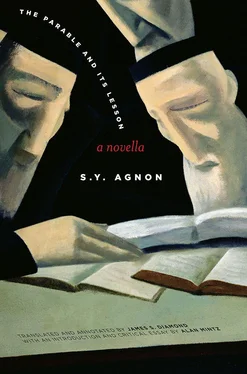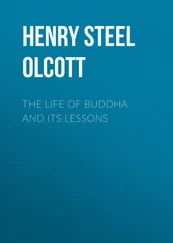On the other hand, there is the evidence of the story itself. This long and unwieldy tale, told by the shamash and staged by the narrator, constitutes in many respects an enormous and flagrant transgression against the very ideal of verbal abstinence that they themselves have so vehemently been promulgating. This wayward prolixity is far from obligatory. To get the business done of describing the horrible punishments of the sinning scholars and thus acquit himself of delivering his monitory message, the shamash could have vastly reduced the amplitude of his account. A principle of utility would have eliminated not only the numerous digressions but also a great swath of the story devoted to describing the conduct of his master, Rabbi Moshe. Yet the reader knows that these seemingly unnecessary accretions and dilations are in fact true expressions of what is really on the shamash’s mind: the trauma induced by what he saw so many years ago, and the loss of his connection to the great and holy man he served so devotedly.
OUR MASTER
Why does Agnon’s narrator loosen the reins and allow the shamash to take over the story? To be sure, the principled audacity he displays in banishing the talkative young scholar and then standing up to the judges of the rabbinic court marks him as a person of high resolve. But his true merit lies less in his character than in his utility to the story. This is a story about occurrences so remarkable and bizarre that only the authority of an eyewitness account has a chance of overcoming the reader’s incredulity. It is a story, moreover, whose principle actor is a taciturn rabbi whose enigmatic actions require careful observation and explication. Who better to observe and explicate them than his devoted personal assistant? The shamash functions as a lens through which we take in the moral and spiritual eminence of the figure referred to, throughout the original text, as rabeinu , our Master, as if in using the first person plural the shamash speaks for the community as a whole. As the name of his office implies, the shamash’s function is to serve his master. Yet, ironically as we shall see, despite this subservience the gruff and protective secretiveness that surrounds the shamash projects a fascination on the reader that rivals the rabbi’s mystique.
It is the rabbi who is placed squarely at the moral center of the story, even if the narrator unintentionally accepts the existence of competing currents of interest. That a moral center be established is crucial to Agnon here, as it is generally in ‘Ir umelo’ah , because the deviations from the norm, which interest his fiction as much as does the norm itself, can be located and described only in reference to the norm. Rabbi Moshe unambiguously occupies that center. He does so not only because of his personal qualities but also because he exemplifies the rabbinic “rulers” of Buczacz. In introducing Rabbi Moshe in the opening sentence of our story, the narrator states that the tale is part of his project “to describe our masters who reigned [ shemalkhu ] one after the other over our town.” The succession of Buczacz’s rabbis resembles a king list in an ancient chronicle. The rabbi is a Judaic version of Plato’s philosopher-king, and in the ideal vision of Buczacz as a qehilah qedoshah , a holy community informed by Jewish law, the rabbi, as the av beit din , the head — literally, the father — of the court is the ultimate arbiter of authority. Again, it is important to distinguish between the ideal and the idealized. The rulership of the rabbi as an ideal obtains only when, as a class, rabbinic authority is recognized as paramount, and when, as an individual, the rabbi is the worthy exemplar of this high authority.
Already in our story we are witness to a falling away from the ideal; for in the fifty-four years that separate the main events from the present of the telling there is a recognizable diminution of this high standard. A small detail hints at a broad and troubling problem. When it comes to putting together a panel of judges to take up the case of the shamash the day after the incident in the synagogue, the chief rabbi, the town’s av beit din , recuses himself from the proceedings, explaining that his fondness for scholars may not enable him to give the case of the shamash a fair hearing. Although this compunction presents itself as merely a zealous regard for the honor of Torah study, it is in fact symptomatic of a pervasive and systemic perversion that has infected the religious life of Buczacz. Torah study has become commodified and fetishized, and scholarship has become an arena for performance rather than piety. As presented by the narrator at the outset of the story, the offending son-in-law — and by extension his father-in-law, who “acquired” him for his daughter — are the embodiment of the problem.
A wealthy man from the upper crust of our town took as his son-in-law a learned young man from a prominent family. The boy was skilled at advancing all kinds of novel interpretations of our holy texts, even when their meanings were already transparent. In fact, sometimes, in his encounter with a text, he would pronounce his own interpretation before he had even digested its plain sense. 14I refer here not to the nature of his insights but to the fact that his eagerness to propose them overrode any capacity he had for self-restraint. (2)
The ability to come up with novel interpretations ( leḥadesh ḥidushim ) is an index of scholarly brilliance, but when that ability becomes a socially sanctioned compulsion, then brilliance and piety part company. The language produced by human ingenuity competes with the language of the holy texts rather than serving it. If this were simply the young man’s particular pathology, then the matter would not be troubling. But he has been “taken” by one of the town’s wealthy men precisely because his scholarly brilliance can so readily and abundantly be put on display. The public performance of brilliance has become a valuable commodity for conspicuous consumption.
The craving for ḥidushim and the impatience with the plain meaning of the text are ills that have only recently taken root in Buczacz. This is a town in which respect for God’s word is the norm during the Torah reading, and the son-in-law’s flouting of that discipline is explained in part by his being an outsider and a recent arrival. Nevertheless, there is growing indulgence for behavior of this kind; tellingly, the wrath of the town is incited not by his transgression but by the shamash’s disregard for the respect due the wealthy and the learned. The shamash’s scandalous intervention is the gesture that creates a bridge to the Buczacz of a half century earlier when such a permissive and inadvertent collusion would have been unthinkable. This was the era when “Buczacz was Buczacz” and the town was “ruled” by Rabbi Moshe and by the true values he both represented and enforced.
Rabbi Moshe’s greatness is established in part by his prophetic ability to identify this tendency to unrestrained performative speech as a sin and foresee that it would bedevil his community long after his death. When he made conversing during the Torah reading the subject of the great discourse he delivered on the twentieth of Sivan, the crescendo of the story and his valedictory address before his death, his listeners must surely have been dumbfounded as to the choice of topic. The rabbi admits that this is a transgression he himself has never witnessed but merely heard about (47). It is only we the readers, who have been given access by the shamash to the dark revelations of Gehinnom, who are positioned to appreciate the momentousness of the rabbi’s subject. Yet, like the desperate efforts of his biblical namesake, Rabbi Moshe’s fierce homiletic warnings prove incapable of staving off the folly that will take root in the next generation. In the comedic turn the story takes in its conclusion, it is only the courageous ire of the ancient shamash that can break the cycle and prevent the insidious growth from spreading.
Читать дальше












![Edward Ellis - Adrift on the Pacific - A Boys [sic] Story of the Sea and its Perils](/books/753342/edward-ellis-adrift-on-the-pacific-a-boys-sic-s-thumb.webp)